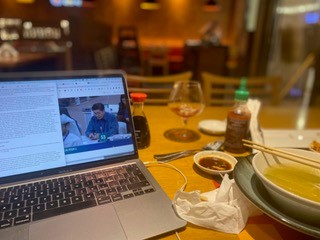In this blog, Hannah Hughes of Aberystwyth University reflects upon the increased virtual space of climate negotiations. Whilst this shift, initially precipitated by COVID, has the potential of reducing the emission cost of global diplomacy, Hughes also highlights that there are new difficulties to be recognised. Finally, she provides some ‘top tips’ for following negotiations online.
For a while now I have been wanting to reflect on the possibility of following and analysing the COP from afar – to look back on the otherside of the pandemic and to see if the hope I held for virtual research still held.

The pandemic struck when I was co-editor of a collaborative project with Alice Vadrot to develop a methodological guide on the study of global environmental negotiations. One of the main objectives of the project was to broaden the actors, sites and processes that were studied as constitutive of collective action. The pandemic arrived as we were conceptualising the agreement-making framework for the book. Going into lockdowns and moving into the virtual meeting space offered an opportunity to consider whether the central site around which agreement-making activity is orientated – the Conference of the Parties (COP), global summits and other intergovernmental meetings – could be studied from a distance.
For my own part, I felt hope in the shift to virtual processes on three fronts: 1) it could significantly reduce emissions of global conferencing; 2) it offered the potential to broaden participation; 3) it could enable researchers with limited budgets, difficulties travelling and caring responsibilities to observe and study these meetings. This optimism however, was quickly tempered through personal experience.
In November 2021, just after we’d finished the article, I observed a virtual facilitative working group meeting of the newly established Local Community and Indigenous Peoples Platform (LCIPP) and both my sons were home. I was nominated to attend the meeting as a member of the RINGO (Research and Independent Non-Governmental Organisation) constituency, and as such, I was responsible for submitting notes on the meeting along with three other researchers in virtual attendance. It was impossible for me to follow all the sessions of the meeting and take detailed notes while at the same time, taking care of the entertainment, eating and toileting needs of a two and seven year old. I felt bad for not providing a fair share of meeting notes, stressed by attempting to parent and research simultaneously and annoyed at missing so much of the meeting.
The parts of the meeting I was able to follow made it clear that other attendants were struggling with participation in their surroundings. Poor internet connection, time zones and barking dogs made apparent that while emissions had been reduced and access for some may have been gained due to the virtual setting – meaningful participation was definitely not guaranteed for all and may have been reduced for many.
In January and March 2022, I observed the approval of Working Group II and III’s contribution to the IPCC’s Sixth Assessment Report. The usual four day in-person meeting was extended to a two week long virtual session for the line-by-line approval of the Summary for Policymakers. These meetings were held during the teaching semester, and I quickly ran into the same frustration with juggling work, family and participant observation. The interviews I conducted following the meeting revealed a similar pattern. Not being away from the office meant it was hard for some participants to escape the normal day-to-day duties that are expected whether that is in a government office or an academic department, and being at home means that caring responsibilities are unlikely to be redistributed as they would during a scheduled trip. It became clear that the virtual meeting space was in fact bringing up similar divides and asymmetries as participation in a ‘normal’ intergovernmental meeting.
In fact, some of these asymmetries appeared to be heightened in the virtual space. Women, for example, were more likely to be visibly manoeuvring the home space and its divided attentions and responsibilities. Participants from the global South were more likely to be struggling with poor internet connection, which meant that some delegates were using mobile phones and/or resorted to the chat. In many instances, gender and location intersected. Interviews further illuminated that while some well-invested and resourced national delegations were put up in a nearby hotel, one delegate from a developing country did his office duties by day and the approval session most of the night, which made it nearly impossible to sustain the usual level of participation.
In the run up to COP28 there was a lot of commentary and opinion on who should attend this global negotiation of climate change and why. I attended the first week of the COP to observe the negotiation of the outcome of the Global Stocktake (GST), which I’d followed for the past twelve months as part of my research on the ESRC project ‘The Politics of Science in Climate Cooperation’, led by Patrick Bayer (Glasgow University) with myself and Erlend Hermansen (CICERO) as co-investigators. COPs are more than negotiations however, running in parallel are hundreds of side events, where accounts of the latest climate knowledge and action are presented. This can make these events relevant to researchers both as sites of observation and as sites for testing out analysis of these observations.
During the first contact group I was forced to use the online platform to follow the informal meeting as there was no space in the room. This was the first time that I had been at a COP following a meeting virtually, and I liked it. I was alone at the COP venue or in my hotel room and able to follow every word without my laptop balanced on my knees. That is, until there was some technical issue, which meant that the stream was interrupted, or the scheduled recording finished while the meeting ran over time. As researchers we are used to being unable to get in the room or having to leave the room because we aren’t supposed to sit on the floor. In that respect, chasing the technical support to get back on the virtual platform is not dissimilar to waiting outside to hear what’s taken place inside. The virtual platform also offered the advantage of being able to eat and go to the loo!
Meetings were being streamed and recorded before COVID, but now it is much more systematic. The UNFCCC virtual platform can be registered for as an observer and followed from anywhere in the world (with sufficient internet speed). It makes following from afar possible and certainly offers the opportunity for research on global environmental negotiations to be done from a distance. However, equally important as access to the room is immersion in the surroundings. The virtual platform can offer a degree of immersion, and even more so if you are already familiar with these venues and the intergovernmental setting.
For the virtual to offer this same immersive experience some careful planning and engineering of your personal surroundings is key. A quiet room, a capacity to adapt to different time zones, an ability to switch off from the world at home and enter the world of the negotiations on the screen. If achieved, this way of working has the potential to make virtual observation and ethnography an important research tool in the study of agreement-making, without the air miles.
Top tips for following virtually:
- UNFCCC virtual platform: Test beforehand and ask advice from technical support if you have any issues. For example, some browsers worked better than others.
- Work together: oftentimes there are several researchers following the same events – try to establish a WhatsApp group or some other form of communication so that you can share information on parts of the meeting missed.
- Use social media: Twitter/X remains an important real time source of information around these meetings. There were several researchers posting about the text I was following from the room and that gave me another perspective on events.
- Other resources: The Ringo website, Carbon Brief text tracker, Eco Newsletter, ENB daily reports and summaries and the ENB halfway point webinar are all incredibly valuable resources for immersing in the COP experience.

Bio: Hannah Hughes is Senior Lecturer in International Politics and Climate Change at Aberystwyth University. She is interested in the relationship between knowledge and power in how we know and respond to global environmental degradation, with a particular focus on climate change as studied through the IPCC and UNFCCC. You can find out more about her research and publications here.
